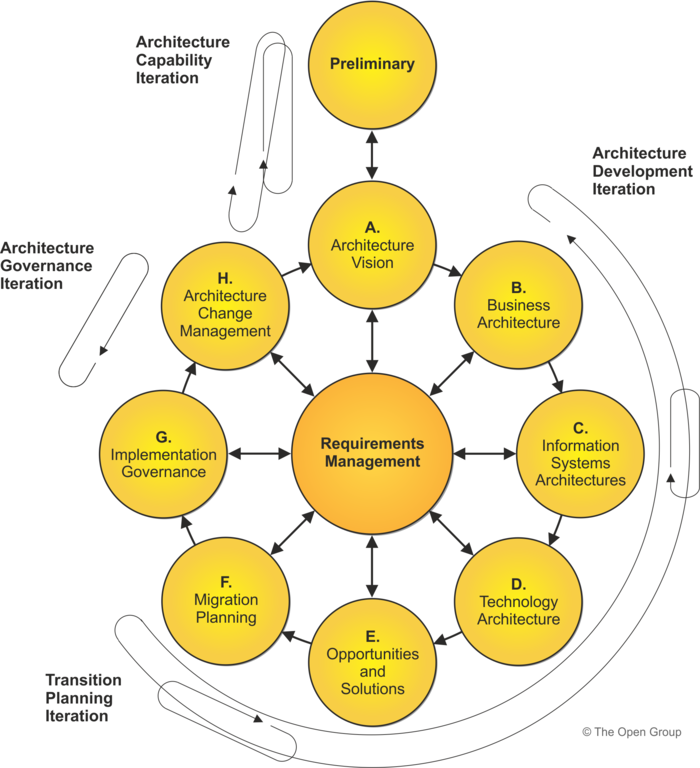Introduction
Embarking on the journey of enterprise architecture requires a robust and flexible framework, and TOGAF’s Architecture Development Method (ADM) stands as a beacon in the dynamic landscape of organizational design. In this guide, we delve into the intricacies of the TOGAF ADM, unraveling its cyclic structure, iterative nature, and the art of systematically addressing complex requirements across various architecture domains.
The TOGAF ADM, or Architecture Development Method, is a comprehensive framework for developing and managing enterprise architecture. It consists of a structured set of phases that guide architects through the process of creating, maintaining, and evolving an enterprise architecture.

Preliminary Phase:
- Lay the groundwork for success by preparing the organization for TOGAF projects.
- Define an Organization-Specific Architecture framework, tools, and principles to align with business directives.
Phase A: Architecture Vision:
- Set the scope, constraints, and expectations for the project.
- Create the Architecture Vision, define stakeholders, validate the business context, and obtain necessary approvals.
Phase B, C, D: Business, Information Systems, and Technology Architecture:
- Develop Baseline and Target Architectures in domains of Business, Information Systems (Application & Data), and Technology.
- Analyze gaps and ensure alignment with project objectives.
Phase E: Opportunities & Solutions:
- Perform initial implementation planning.
- Identify delivery vehicles for building blocks and group major projects into Transition Architectures.
Phase F: Migration Planning:
- Analyze cost benefits and risks.
- Develop a detailed Implementation and Migration Plan for seamless execution.
Phase G: Implementation Governance:
- Provide architectural oversight for implementation.
- Prepare and issue Architecture Contracts through the Implementation Governance Board.
Phase H: Architecture Change Management:
- Continually monitor and implement a change management process.
- Ensure the architecture aligns with enterprise needs and maximizes value to the business.
Requirements Management:
- Base every stage on and validate business requirements.
- Identify, store, and prioritize requirements, feeding them into relevant ADM phases.
In “TOGAF ADM Unveiled,” dive into the intricacies of each phase, understanding their role in crafting a resilient and effective enterprise architecture. From vision to implementation, this guide demystifies the journey to architectural excellence.
TOGAF ADM: Iterative Approach:
Let’s break down the nature of the TOGAF ADM:
Cyclic Structure:
- The ADM is depicted in a circular manner, highlighting its iterative nature. This circular structure emphasizes that the completion of one phase feeds directly into subsequent phases, creating a continuous loop of refinement and development.
Iteration occurs at three levels:
- Cycling around the ADM: The entire ADM process is applied iteratively, allowing architects to revisit and refine different phases as needed.
- Iterating between phases: Architects have the flexibility to move back and forth between phases. For example, after completing the Technology Architecture phase, one might return to the Business Architecture phase for further refinement.
- Cycling around a single phase: Within each phase of the ADM, there is support for repeated execution of activities. This enables architects to delve deeper into specific aspects of the architecture, refining and elaborating content as necessary.
Validation and Feedback:
- Frequent validation of results against the original requirements is a crucial aspect of the ADM. This validation occurs both at the overall ADM cycle level and within each individual phase.
- Consideration of scope, detail, schedules, and milestones is essential during the validation process.
Asset Reuse and Integration:
- The ADM encourages the reuse of assets produced in previous iterations of the process. This includes leveraging architectural artifacts and insights from earlier cycles to inform and enhance current work.
- External assets from the marketplace, such as other frameworks or models, are also considered and integrated into the architecture development process.
Phased Architecture Domains:
- The ADM guides architects through a range of architecture domains, ensuring that the complex set of requirements is systematically addressed. These domains typically include Business Architecture, Data Architecture, Application Architecture, and Technology Architecture.
The TOGAF ADM is a flexible and iterative framework that allows architects to systematically develop and refine enterprise architecture. Its cyclic structure, iterative approach, emphasis on validation, and integration of assets contribute to its effectiveness in managing the complexities of architectural development.
Summary
Discover the power of iteration as we navigate the circular path of the ADM, exploring how each completed phase seamlessly feeds into the next. Validation becomes a cornerstone, ensuring that the architecture aligns with the ever-evolving requirements. With the freedom to iterate between phases and cycle within a single phase, architects gain a nuanced understanding of their enterprise landscape.
We emphasize the significance of asset reuse and integration, leveraging insights from previous cycles and external market assets. From Business Architecture to Technology Architecture, each domain is meticulously addressed. The TOGAF ADM emerges not just as a methodology but as a dynamic process that adapts to the unique challenges of each enterprise.
In “Navigating Complexity,” embark on a journey of architectural refinement, where the iterative dance of the ADM transforms complexity into a well-orchestrated symphony of interconnected components.